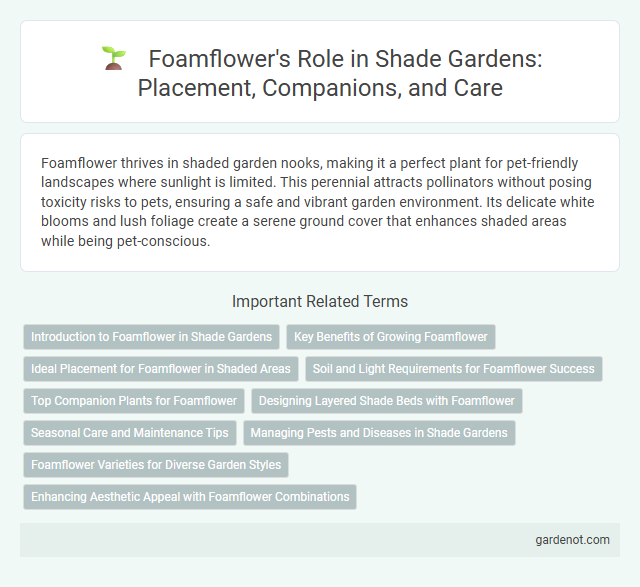Foamflower thrives in shaded garden nooks, making it a perfect plant for pet-friendly landscapes where sunlight is limited. This perennial attracts pollinators without posing toxicity risks to pets, ensuring a safe and vibrant garden environment. Its delicate white blooms and lush foliage create a serene ground cover that enhances shaded areas while being pet-conscious.
Introduction to Foamflower in Shade Gardens
Foamflower (Tiarella cordifolia) thrives in shade gardens, offering delicate, frothy white blossoms that brighten dimly lit areas. This native perennial prefers moist, well-drained soil and dappled sunlight, making it ideal for under-tree or woodland garden settings. Its attractive, lobed foliage provides year-round interest and supports biodiversity by attracting pollinators such as bees and butterflies.
Key Benefits of Growing Foamflower
Foamflower (Tiarella cordifolia) thrives in shade gardens, offering vibrant foliage and delicate, foamy white blooms that enhance under-canopy spaces. Its natural resistance to deer and adaptability to moist, well-drained soils reduce maintenance efforts in shaded, woodland settings. Foamflower also supports local biodiversity by attracting pollinators, making it a sustainable and visually appealing groundcover choice for shade gardens.
Ideal Placement for Foamflower in Shaded Areas
Foamflower thrives best in shaded garden areas with rich, well-drained soil that retains moisture without becoming waterlogged. Positioning Foamflower under deciduous trees or alongside hostas ensures partial to full shade, mimicking its natural woodland habitat. Consistent shade and adequate humidity promote lush foliage and vibrant blooms, enhancing the garden's understory aesthetic.
Soil and Light Requirements for Foamflower Success
Foamflower thrives in rich, well-draining, consistently moist soil with a high organic matter content, ideal for shade garden environments. It prefers partial to full shade, avoiding direct sunlight that can scorch its delicate leaves and reduce flowering. Providing dappled light beneath deciduous trees or shrubs ensures optimal growth and vibrant blooms.
Top Companion Plants for Foamflower
Foamflower thrives alongside shade-loving companions such as hostas, ferns, and astilbes, which share similar moisture and light requirements. These plants create a lush, layered garden bed that enhances the delicate white blooms of Foamflower while providing contrasting textures and foliage colors. Selecting companions like lungwort and jack-in-the-pulpit further enriches the shade garden ecosystem, promoting biodiversity and year-round interest.
Designing Layered Shade Beds with Foamflower
Foamflower (Tiarella cordifolia) thrives in shaded garden beds, offering delicate, frothy blooms and attractive foliage that enhances layered shade designs. Pairing Foamflower with hostas, ferns, and heuchera creates a dynamic understory, combining textures and varying leaf colors for visual interest. Its adaptability to moist, well-drained soils and tolerance of deep shade make Foamflower a key plant for adding depth and softness to multi-layered shade gardens.
Seasonal Care and Maintenance Tips
Foamflower (Tiarella cordifolia) thrives in shaded garden areas, requiring moist, well-drained soil rich in organic matter for optimal growth. Seasonal care involves mulching in late fall to protect roots from winter cold and cutting back old foliage in early spring to encourage fresh growth. Regular watering during dry spells and removing spent flower stalks maintain plant health and enhance the garden's visual appeal throughout the growing season.
Managing Pests and Diseases in Shade Gardens
Foamflower (Tiarella cordifolia) thrives in shade gardens but requires vigilant management to prevent common pests like slugs and aphids, which can damage its delicate foliage. Maintaining good air circulation and removing decayed leaves reduces fungal diseases such as powdery mildew and leaf spot, preserving plant health. Applying organic insecticides and regular monitoring ensures early detection and effective control, supporting vibrant and disease-free growth in shaded environments.
Foamflower Varieties for Diverse Garden Styles
Foamflower varieties such as Tiarella cordifolia, Tiarella wherryi, and Tiarella stolonifera provide diverse texture and color to shade gardens, thriving in moist, well-drained soil. Tiarella cordifolia features white blooms with pinkish hues and lobed leaves, ideal for woodland or naturalistic garden styles. In contrast, Tiarella wherryi showcases more vibrant foliage and delicate flowers, perfect for adding visual interest to mixed perennial borders or shaded rock gardens.
Enhancing Aesthetic Appeal with Foamflower Combinations
Foamflower (Tiarella cordifolia) creates a striking visual impact in shade gardens when paired with hostas, ferns, and astilbes, blending delicate blooms and textured foliage. Combining Foamflower's frothy white or pink blossoms with the bold leaves of hostas enhances the garden's depth and contrast, promoting a lush, layered look. Strategic placement of Foamflower alongside shade-adapted perennials boosts year-round aesthetic appeal through varied colors and forms, enriching garden composition.
Foamflower niche Infographic

 gardenot.com
gardenot.com